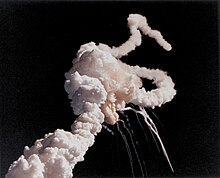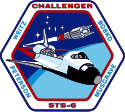Challenger (Raumfähre)




Das Space Shuttle Challenger (englisch für Herausforderer) war eine Raumfähre der NASA, die zwischen April 1983 und Januar 1986 zehn Raumflüge absolvierte. Ihre interne Bezeichnung lautete OV-099. Ursprünglich als Plattform für Bodentests gebaut, wurde sie später für Einsätze im Weltraum umgerüstet. Bei der Challenger-Katastrophe am 28. Januar 1986 explodierte die Raumfähre kurz nach dem Start, wobei ihre Besatzung ums Leben kam.
Geschichte
Die Challenger wurde als dritter Space-Shuttle-Orbiter (nach dem Prototyp Enterprise und dem ersten voll einsatzfähigen Space-Shuttle-Orbiter Columbia) in den aktiven Dienst der NASA übernommen. Seinen Namen erhielt das Raumschiff nach dem britischen Forschungsschiff Challenger, das von 1872 bis 1876 die Weltmeere befuhr. Auch die Mondlandefähre von Apollo 17 trug diesen Namen.
Im Februar 1972 erhielt das Luft- und Raumfahrtunternehmen Rockwell International (heute Teil von Boeing) den Auftrag zum Bau von zunächst zwei Space-Shuttle-Orbitern, Enterprise und Challenger, die beide für Bodentests und noch nicht für den Einsatz im All gedacht waren.
Verwendung für Bodentests
Als Test-Orbiter für das Shuttle-Programm konzipiert, wurde die Challenger nach ihrer Fertigstellung im Mai 1977 zunächst fast ein Jahr lang unter der internen Bezeichnung STA-099 (STA steht für Structural Test Article) für Schwingungstests verwendet.
Ab 1979 wurde die Challenger dann nachträglich anstelle der Enterprise (dem ersten Structural Test Article, mit welchem Abwurf- und Landetests durchgeführt wurden) zu einer vollwertigen und raumflugfähigen Raumfähre ausgebaut. Im Oktober 1982 für den Einsatz im All fertiggestellt, erhielt die Challenger auch die neue interne Bezeichnung OV-099 zugeteilt.
Einsatz im Flugbetrieb
Der Jungfernflug der Challenger erfolgte im April 1983 (STS-6). Sie unternahm insgesamt neun vollständige Raumflüge (jeweils drei in den Jahren 1983, 1984 und 1985), wobei sie zusammengenommen 69 Tage im Weltraum war und 987 Erdumkreisungen absolvierte.
Am 28. Januar 1986, 73 Sekunden nach dem Start der Mission STS-51-L, explodierte die Raumfähre in etwa 15 Kilometer Höhe[1] (siehe Challenger-Katastrophe). Dabei starben alle sieben Astronauten. Als Grund wurde das Versagen eines oder mehrerer Dichtungsringe in einer der seitlichen Feststoffraketen ermittelt. Es war der bis dahin schwerste Unfall in der Raumfahrtgeschichte der USA.
Missionen
Verbleib
Die nach der Explosion geborgenen Wrackteile der Challenger sind heute in einem ehemaligen Raketensilo im Startkomplex 31 der Cape Canaveral Space Force Station eingelagert.
1996 wurden zwei Teile der Challenger bei der Stadt Cocoa Beach in Florida an Land gespült.[2] Im November 2022 fand eine Filmcrew auf der Suche nach Artefakten des Zweiten Weltkrieges ein etwa viereinhalb Meter langes Bruchstück des Shuttles im Atlantik, dessen Authentizität von der NASA bestätigt wurde. Dies war der erste Fund eines Wrackteils seit 1996.[3][4]
Medien
Der Challenger-Katastrophe wurden zahlreiche Fernseh-Dokumentationen und auch mehrere Spielfilme gewidmet.
Im Jahr 2013 wurde der Spielfilm The Challenger veröffentlicht, der die Untersuchung des Unfalls thematisiert.
Weblinks
- Raumfahrer.net: Der Orbiter Challenger (OV-099)
- NASA: Beschreibung und Flüge der Challenger (englisch)
- NASASpaceflight.com: Chronik der Raumfähre Challenger (englisch)
Einzelnachweise
- ↑ Martin Holland: 30 Jahre Challenger-Unglück: die erste große Katastrophe der US-Raumfahrt. In: heise online. 28. Januar 2016, abgerufen am 10. Dezember 2019.
- ↑ Challenger Parts Wash Ashore Almost 11 Years After Explosion. In: The New York Times. 18. Dezember 1996 (nytimes.com [abgerufen am 1. Januar 2025]).
- ↑ Tanja Banner: Filmcrew macht überraschende Entdeckung im Meer – Nasa bestätigt Fund. In: Frankfurter Rundschau. 11. November 2022, abgerufen am 11. November 2022.
- ↑ James Bikales: Film crew stumbles upon piece of Challenger 36 years after tragedy, NASA says. In: The Washington Post. 10. November 2022 (englisch).
Auf dieser Seite verwendete Medien
STS-6 Crew Insignia
STS-8 INSIGNIA --- The night launch of Challenger heading toward its third earth-orbital mission is featured in the official insignia for STS-8. The eighth flight of the United States Space Transportation System is represented by eight stars of the constellation Aquila, "The Eagle," Astronauts Richard H. Truly, commander; Daniel C. Brandenstein, pilot; Dale A. Gardner, Guion S. Bluford, and William E. Thornton--all mission specialists--have their sumames on the border of the insignia.
PHOTO CREDIT: NASA or National Aeronautics and Space AdministrationThe patch features a helmet visor of an astronaut performing an extravehicular activity. In the visor are reflected the sun's rays, the Challenger and its remote manipulator system (RMS) deploying the long duration exposure facility (LDEF), the Earth and blue sky, and another astronaut working at the damaged Solar Maximum Satellite (SMS). The scene is encircled by the surnames of the crewmembers.
STS-61A Mission Insignia
- This insignia was chosen by the eight members of the STS-61A/D1 Spacelab mission to represent the record-sized Space Shuttle crew. Crewmembers surnames surround the colorful patch scene depicting Challenger carrying a long science module and an international crew from Europe and the United States.
STS-51-L INSIGNIA
- Members of the STS-51L crew designed this patch which will represent their participation on NASA's late January 1986 mission aboard the space shuttle Challenger, depicted launching from Florida and soaring into space to carry out a variety of goals. Among the prescribed duties of the five astronauts and two payload specialists will be observation and photography of Halley's Comet, backdropped against the United States flag in the insignia. Surnames of the crew members encircle the scene, with the payload specialists being recognized below. Surname of the first teacher in space, Sharon Christa McAuliffe, is followed by a symbolic apple. Gregory Jarvis, representing Hughes, is the industrial payload specialist for the flight. NASA's crew members are astronauts Francis R. (Dick) Scobee, commander; Michael J. Smith, pilot; and Ronald E. McNair, Ellison S. Onizuka and Judith A. Resnik - all mission specialists.
STS07-32-1702 (22 June 1983) --- The Earth-orbiting space shuttle Challenger beyond the Earth's horizon was captured by a 70mm camera onboard the unmanned, free-flying Shuttle Pallet Satellite (SPAS-01) during the busy flight day 5 of the STS-7 mission. Visible in the cargo bay are the protective cradles for the now-vacated Telesat Anik C-2 and Palapa B communications satellites, the pallet for the NASA Office of Space and Terrestrial Applications (OSTA-02), the Remote Manipulator System (RMS) and the KU-Band antenna. The STS-7 crew with the RMS later retrieved the SPAS and returned it to a stowed position in the cargo bay for return to Earth. Photo credit: NASA or National Aeronautics and Space Administration
- Short Description: Space Shuttle Challenger explodes shortly after take-off.
- Full Description: On January 28, 1986, the Challenger space shuttle and her seven-member crew were lost when a ruptured O-ring in the right solid rocket booster caused an explosion soon after launch. This photograph, taken a few seconds after the accident, shows the main engines and solid rocket booster exhaust plumes entwined around a ball of gas from the external tank. Because shuttle launches had become almost routine after 24 successful missions, those watching the shuttle launch in person and on television found the sight of the explosion especially shocking and difficult to believe until NASA confirmed the accident.
- Image # : 86-HC-220
- Title: Exhaust Trail of STS-51-L
NASA space shuttle orbiter Challenger, riding on the 747/shuttle carrier aircraft, returns to Kennedy Space Center after landing at Edwards Air Force Base in California at the conclusion of its mission, April 1984.
Aufstieg der Raumfähre Atlantis am 2. Dezember 1988 mit der Mission STS-27.
Emblem of Nasa's STS-7 mission.
The title says it all. She landed at Edwards Air Force Base on April 9th, 1983. The ill-fated Orbiter completed the first of her 10 flights, which as we all know, culminated in her destruction on January 28th, 1986, during the launch of STS-51-L, the 25th Space Shuttle Mission, killing her brave crew of seven.
Logo of Nasa's STS-51-F mission.















